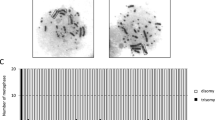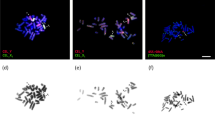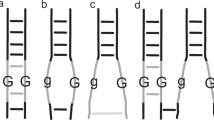Abstract
THE statement that “only two homologous chromosomes can pair at one time” is one of the most basic of cytogenetic principles. It is founded on observations of meiosis in triploid and tetraploid organisms1–7 which have suggested that if three homologues are present, they will occur as a pair and a single unpaired chromosome. If four homologues are present, the chromosomes may exchange pairing partners, but they occur as two separate pairs. We now present evidence that the chromosomes of the triploid chicken are not bound by these rules and are capable of “triple pairing”.
This is a preview of subscription content, access via your institution
Access options
Subscribe to this journal
Receive 51 print issues and online access
$199.00 per year
only $3.90 per issue
Buy this article
- Purchase on Springer Link
- Instant access to full article PDF
Prices may be subject to local taxes which are calculated during checkout
Similar content being viewed by others
References
Newton, W. C. F., and Darlington, C. D., J. Genet., 21, 1 (1929).
Darlington, C. D., J. Genet., 24, 65 (1931).
Darlington, C. D., J. Genet., 31, 185 (1935).
Darlington, C. D., Cytology, 119 (Churchill, London, 1965).
Moens, P. B., Canad. J. Genet. Cytol., 10, 799 (1968).
Moens, P. B., J. Cell Biol., 40, 273 (1969).
Moens, P. B., J. Cell Sci., 7, 53 (1970).
Ohno, S., Kittrell, W. A., Christian, L. C., Stenius, C., and Witt, G. A., Cytogenetics, 2, 42 (1963).
Comings, D. E., and Okada, T. A., Nature, 227, 451 (1970).
Comings, D. E., and Okada, T. A., Chromosoma, 30, 269 (1970).
Comings, D. E., and Okada, T. A., Exp. Cell Res., 65, 104 (1971).
Moses, M. J., Ann. Rev. Genet., 2, 363 (1968).
Moens, P. B., Chromosoma, 28, 1 (1969).
Brinkley, B. R., and Bryan, J. H. D., J. Cell Biol., 23, 14A (1964).
Coleman, J. R., and Moses, M. J., J. Cell Biol., 23, 63 (1964).
Nebel, B. R., and Coulon, E. M., Chromosoma, 13, 292 (1962).
Callan, H. G., J. Cell Sci., 2, 1 (1967).
Whitehouse, H. L. K., J. Cell Sci., 2, 9 (1967).
Moens, P. B., Chromosoma, 23, 418 (1968).
Redfield, H., Genetics, 15, 205 (1930).
Author information
Authors and Affiliations
Rights and permissions
About this article
Cite this article
COMINGS, D., OKADA, T. Triple Chromosome Pairing in Triploid Chickens. Nature 231, 119–121 (1971). https://doi.org/10.1038/231119a0
Received:
Issue Date:
DOI: https://doi.org/10.1038/231119a0
This article is cited by
-
Chromosome pairing in autotetraploid Bombyx males. Inhibition of multivalent correction by crossing over
Carlsberg Research Communications (1987)
-
Synaptonemal complex spreading in Allium
Chromosoma (1986)
-
Meiotic configurations in female trisomy 21 foetuses
Human Genetics (1984)
-
Synaptonemal complex formation and distribution of recombination nodules in pachytene trivalents of triploid Coprinus cinereus
Carlsberg Research Communications (1981)
-
Chromosome pairing in triploid females of Bombyx mori analyzed by three dimensional reconstructions of synaptonemal complexes
Carlsberg Research Communications (1977)
Comments
By submitting a comment you agree to abide by our Terms and Community Guidelines. If you find something abusive or that does not comply with our terms or guidelines please flag it as inappropriate.



